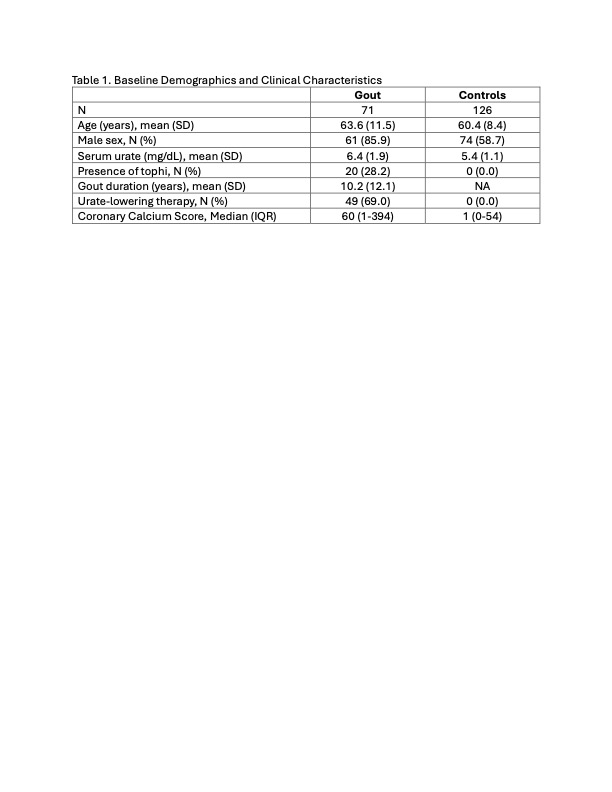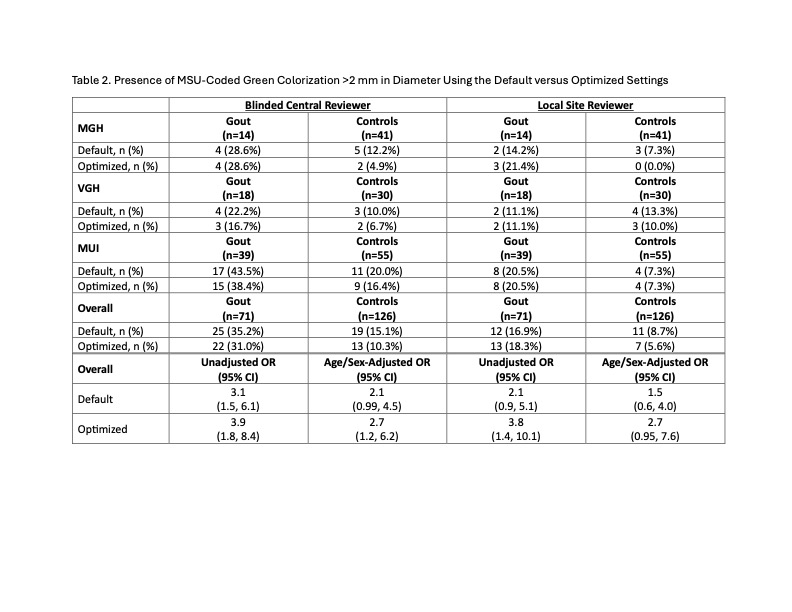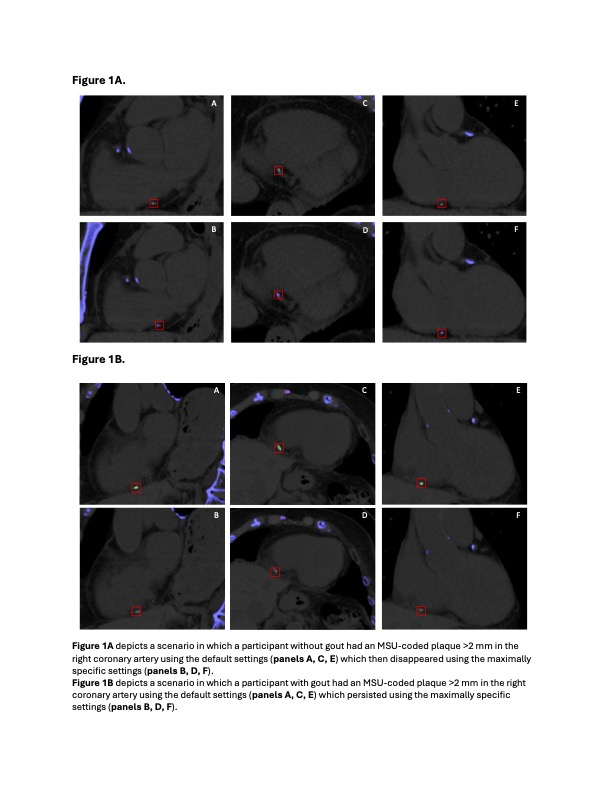Session Information
Date: Sunday, November 17, 2024
Title: Metabolic & Crystal Arthropathies – Basic & Clinical Science Poster II
Session Type: Poster Session B
Session Time: 10:30AM-12:30PM
Background/Purpose: Prior dual-energy CT (DECT) studies have suggested that monosodium urate (MSU) crystals may be present in the coronary arteries of patients with gout. However, the application of DECT to cardiovascular imaging poses unique challenges and is susceptible to false-positive findings not routinely encountered in musculoskeletal imaging. Thus, we conducted a multi-center prospective coronary DECT study using default and maximally specific post-processing settings to determine whether individuals with gout have a higher prevalence of coronary MSU deposition compared to those without gout.
Methods: Individuals with and without gout were recruited to undergo DECT for potential aortic and coronary MSU deposition and coronary artery calcium (CAC) scoring at four institutions with expertise in DECT and gout. Each DECT image was reviewed for the presence of MSU-coded vascular plaques by a blinded central radiologist and a local site radiologist with expertise in DECT using prespecified reading protocols developed by expert consensus. First, the DECT images were processed using the default gout settings on the post-processing workstation, syngo.via (Siemens, Germany). For any MSU-coded areas in the aorta or coronary arteries exceeding >2 mm in diameter, the DECT parameters were changed to maximally specific settings for MSU (i.e., optimized settings). CAC scores were calculated using the Agatston score.
Results: We herein present the results of the imaging data available from three sites: Massachusetts General Hospital (MGH), Vancouver General Hospital (VGH), and Medical University Innsbruck (MUI). This analysis included data from 71 subjects with gout and 126 control subjects without gout whose clinical characteristics are summarized in Table 1, including CAC score, which was higher among subjects with gout than controls (p < 0.001). The blinded central reviewer tended to find a higher prevalence of MSU-coded lesions using both default and optimized settings (Table 2). Using the default settings, subjects with gout had 3.1-fold higher odds (95% CI, 1.5 to 6.1) of having MSU-coded vascular lesions which attenuated after age/sex-adjustment (Table 2). The optimized settings showed a larger OR of 3.9 (95% CI, 1.8 to 9.4), which also attenuated but remained significant after age/sex-adjustment. Figure 1 depicts examples in which MSU-coded lesions using the default settings disappear (Figure 1A) or persist (Figure 1B) using the optimized settings, representing a false-positive finding and an area potentially consistent with MSU deposition and warranting further assessment with advanced DECT parameters, respectively.
Conclusion: In this analysis of a multi-center prospective coronary DECT imaging study, individuals with gout had higher prevalence of MSU-coded plaques in the aorta or coronary arteries using optimized specific settings. Further evaluation using advanced DECT parameters, pathology evaluation, and urate-lowering therapy response follow-up study would lead to confirmation of true MSU deposition versus artifact.
To cite this abstract in AMA style:
Yokose C, Pascart T, Randhawa M, Kennedy P, Schwabl C, chigurupati s, Jiang B, Lu L, Held J, Widmann G, Simeone F, Ghoshhajra B, Sheikh A, Shojania K, Feuchtner G, Klauser A, Nicolaou S, Budzik J, Becce F, Choi H. Coronary Dual-Energy Computed Tomography for the Detection of Monosodium Urate Crystal Deposition in the Arteries of Individuals with and Without Gout (CORODECT): A Multi-Center Prospective Imaging Study [abstract]. Arthritis Rheumatol. 2024; 76 (suppl 9). https://acrabstracts.org/abstract/coronary-dual-energy-computed-tomography-for-the-detection-of-monosodium-urate-crystal-deposition-in-the-arteries-of-individuals-with-and-without-gout-corodect-a-multi-center-prospective-imaging-st/. Accessed .« Back to ACR Convergence 2024
ACR Meeting Abstracts - https://acrabstracts.org/abstract/coronary-dual-energy-computed-tomography-for-the-detection-of-monosodium-urate-crystal-deposition-in-the-arteries-of-individuals-with-and-without-gout-corodect-a-multi-center-prospective-imaging-st/



